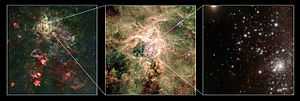R136c
 The bright star to the left of the cluster core is R136c. | |
| Observation data Epoch J2000.0 Equinox J2000.0 | |
|---|---|
| Constellation | Dorado |
| Right ascension | 5h 38m 42.916s |
| Declination | −69° 06′ 04.94″ |
| Apparent magnitude (V) | 12.86 |
| Characteristics | |
| Spectral type | WN5h |
| B−V color index | +0.09 |
| Astrometry | |
| Distance | 165,000 ly |
| Absolute magnitude (MV) | -7.20[1] |
| Details | |
| Mass | >130[2] M☉ |
| Radius | 18.4[1] R☉ |
| Luminosity | 3.0×106[1] L☉ |
| Temperature | 56,000[1] K |
| Age | ~1.7[2] Myr |
| Other designations | |
BAT99 112, RMC 136c | |
| Database references | |
| SIMBAD | data |
R136c is located in the R136 super star cluster, a massive star cluster with 450,000 solar masses and 10,000 stars. It was first resolved and named by Feitzinger in 1980, along with R136a and R136b.[3]
Description
R136c is a Wolf-Rayet star of the spectral type WN5h and with a temperature of 56,000 K. It is at least 130 times the mass of the sun, possibly as much as 175 times, and around three million times more luminous. The extreme luminosity is produced by the CNO fusion process in its highly compressed hot core. Typical of all Wolf-Rayet stars, R136c has been losing mass by means of a strong stellar wind with speeds over 2000 km/s and mass loss rates in excess of 10−5 solar masses per year.[2] It is strongly suspected to be a binary, due to the detection of hard x-ray emission typical of colliding wind binaries, but the companion is thought to make only a small contribution to the total luminosity.[1]
Death
R136c is so energetic that it has already left the main sequence even though it is only a few million years old. Its fate depends on the amount of mass it loses before its core collapses, but is likely to result in a supernova. The most recent models for single star evolution at near-solar metallicities suggest that the most massive stars explode as highly stripped type Ic supernovae, although different outcomes are predicted for binaries. Some of these supernovae are expected to produce a type of gamma-ray burst and the expected remnant is a black hole.[4]
References
- ↑ 1.0 1.1 1.2 1.3 1.4 Hainich, R.; Rühling, U.; Todt, H.; Oskinova, L. M.; Liermann, A.; Gräfener, G.; Foellmi, C.; Schnurr, O.; Hamann, W. -R. (2014). "The Wolf-Rayet stars in the Large Magellanic Cloud". Astronomy & Astrophysics 565: A27. arXiv:1401.5474. Bibcode:2014A&A...565A..27H. doi:10.1051/0004-6361/201322696.
- ↑ 2.0 2.1 2.2 Crowther, P. A.; Schnurr, O.; Hirschi, R.; Yusof, N.; Parker, R. J.; Goodwin, S. P.; Kassim, H. A. (2010). "The R136 star cluster hosts several stars whose individual masses greatly exceed the accepted 150 M⊙ stellar mass limit". Monthly Notices of the Royal Astronomical Society 408 (2): 731. arXiv:1007.3284. Bibcode:2010MNRAS.408..731C. doi:10.1111/j.1365-2966.2010.17167.x.
- ↑ Feitzinger, J. V.; Schlosser, W.; Schmidt-Kaler, T.; Winkler, C. (1980). "The central object R 136 in the gas nebula 30 Doradus - Structure, color, mass and excitation parameter". Astronomy and Astrophysics 84: 50. Bibcode:1980A&A....84...50F.
- ↑ Groh, J. H.; Meynet, G.; Georgy, C.; Ekström, S. (2013). "Fundamental properties of core-collapse supernova and GRB progenitors: Predicting the look of massive stars before death". Astronomy & Astrophysics 558: A131. doi:10.1051/0004-6361/201321906.
| ||||||||||||||||||||||||||||||||||